|
9-1-1. General
Civil aeronautical charts for the U.S. and its
territories, and possessions are produced by the
National Aeronautical Charting Office (NACO),
http://www.naco.faa.gov, which is part of FAA's
office of Technical Operations Aviation Systems
Standards.
9-1-2. Obtaining Aeronautical Charts
a. Most charts and publications described in this
Chapter can be obtained by subscription or one-time
sales from:
National Aeronautical Charting Office (NACO)
Distribution Division,
Federal Aviation Administration
6303 Ivy Lane, Suite 400
Greenbelt, MD 20770
Telephone: 1-800-638-8972 (Toll free within U.S.)
301-436-8301/6990
301-436-6829 (FAX)
e-mail: 9-AMC-Chartsales@faa.gov
b. Public sales of charts and publications are also
available through a network of FAA chart agents
primarily located at or near major civil airports. A
listing of products and agents is printed in the free
FAA catalog, Aeronautical Charts and Related
Products. (FAA Stock No. ACATSET). A free
quarterly bulletin, Dates of Latest Editions, (FAA
Stock No. 5318), is also available from NACO.
9-1-3. Selected Charts and Products
Available
VFR Navigation Charts
IFR Navigation Charts
Planning Charts
Supplementary Charts and Publications
Digital Products
9-1-4. General Description of each Chart
Series
a. VFR Navigation Charts.
1. Sectional Aeronautical Charts. Sectional
Charts are designed for visual navigation of slow to
medium speed aircraft. The topographic information
consists of contour lines, shaded relief, drainage
patterns, and an extensive selection of visual
checkpoints and landmarks used for flight under
VFR. Cultural features include cities and towns,
roads, railroads, and other distinct landmarks. The
aeronautical information includes visual and radio
aids to navigation, airports, controlled airspace,
special-use airspace, obstructions, and related data.
Scale 1 inch = 6.86nm/1:500,000. 60 x 20 inches
folded to 5 x 10 inches. Revised semiannually, except
most Alaskan charts are revised annually.
(See FIG 9-1-1 and
FIG 9-1-11.)
2. VFR Terminal Area Charts (TAC). TACs
depict the airspace designated as Class B airspace.
While similar to sectional charts, TACs have more
detail because the scale is larger. The TAC should be
used by pilots intending to operate to or from airfields
within or near Class B or Class C airspace. Areas with
TAC coverage are indicated by a • on the Sectional
Chart indexes. Scale 1 inch = 3.43nm/1:250,000.
Charts are revised semiannually, except Puerto
Rico-Virgin Islands revised annually.
(See FIG 9-1-1 and
FIG 9-1-11.)
3. World Aeronautical Chart (WAC). WACs
cover land areas for navigation by moderate speed
aircraft operating at high altitudes. Included are city
tints, principal roads, railroads, distinctive landmarks, drainage patterns, and relief. Aeronautical
information includes visual and radio aids to
navigation, airports, airways, special-use airspace,
and obstructions. Because of a smaller scale, WACs
do not show as much detail as sectional or TACs, and;
therefore, are not recommended for exclusive use by
pilots of low speed, low altitude aircraft. Scale
1 inch = 13.7nm/1:1,000,000. 60 x 20 inches folded
to 5 x 10 inches. WACs are revised annually, except
for a few in Alaska and the Caribbean, which are
revised biennially.
(See FIG 9-1-12 and
FIG 9-1-13.)
FIG 9-1-1
Sectional and VFR Terminal Area Charts for the Conterminous U.S.,
Hawaii, Puerto Rico, and Virgin Islands

4. U.S. Gulf Coast VFR Aeronautical Chart. The Gulf Coast Chart is designed primarily for
helicopter operation in the Gulf of Mexico area.
Information depicted includes offshore mineral
leasing areas and blocks, oil drilling platforms, and
high density helicopter activity areas. Scale 1 inch =
13.7nm/1:1,000,000. 55 x 27 inches folded to
5 x 10 inches. Revised annually.
5. Grand Canyon VFR Aeronautical Chart. Covers the Grand Canyon National Park area and is
designed to promote aviation safety, flight free zones,
and facilitate VFR navigation in this popular area.
The chart contains aeronautical information for
general aviation VFR pilots on one side and
commercial VFR air tour operators on the other side.
6. Helicopter Route Charts. A three-color
chart series which shows current aeronautical
information useful to helicopter pilots navigating in
areas with high concentrations of helicopter activity.
Information depicted includes helicopter routes, four
classes of heliports with associated frequency and
lighting capabilities, NAVAIDs, and obstructions. In
addition, pictorial symbols, roads, and easily
identified geographical features are portrayed.
Helicopter charts have a longer life span than other
chart products and may be current for several years.
All new editions of these charts are printed on a
durable plastic material. Helicopter Route Charts are
updated as requested by the FAA. Scale 1 inch =
1.71nm/1:125,000. 34 x 30 inches folded to
5 x 10 inches.
b. IFR Navigation Charts.
1. IFR Enroute Low Altitude Charts
(Conterminous U.S. and Alaska). Enroute low
altitude charts provide aeronautical information for
navigation under IFR conditions below 18,000 feet
MSL. This four-color chart series includes airways;
limits of controlled airspace; VHF NAVAIDs with
frequency, identification, channel, geographic coordinates; airports with terminal air/ground
communications; minimum en route and obstruction
clearance altitudes; airway distances; reporting
points; special use airspace; and military training
routes. Scales vary from 1 inch = 5nm to 1 inch =
20nm. 50 x 20 inches folded to 5 x 10 inches. Charts
revised every 56 days. Area charts show congested
terminal areas at a large scale. They are included with
subscriptions to any conterminous U.S. Set Low (Full
set, East or West sets).
(See FIG 9-1-2 and
FIG 9-1-4.)
FIG 9-1-2
Enroute Low Altitude Instrument Charts for the Conterminous U.S. (Includes Area Charts)
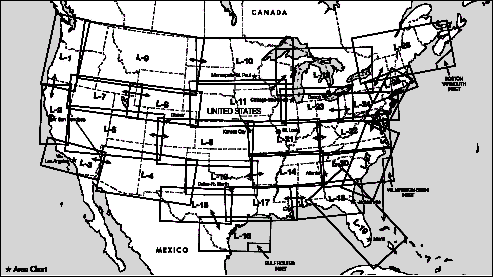
FIG 9-1-3
Enroute High Altitude Charts for the Conterminous U.S.
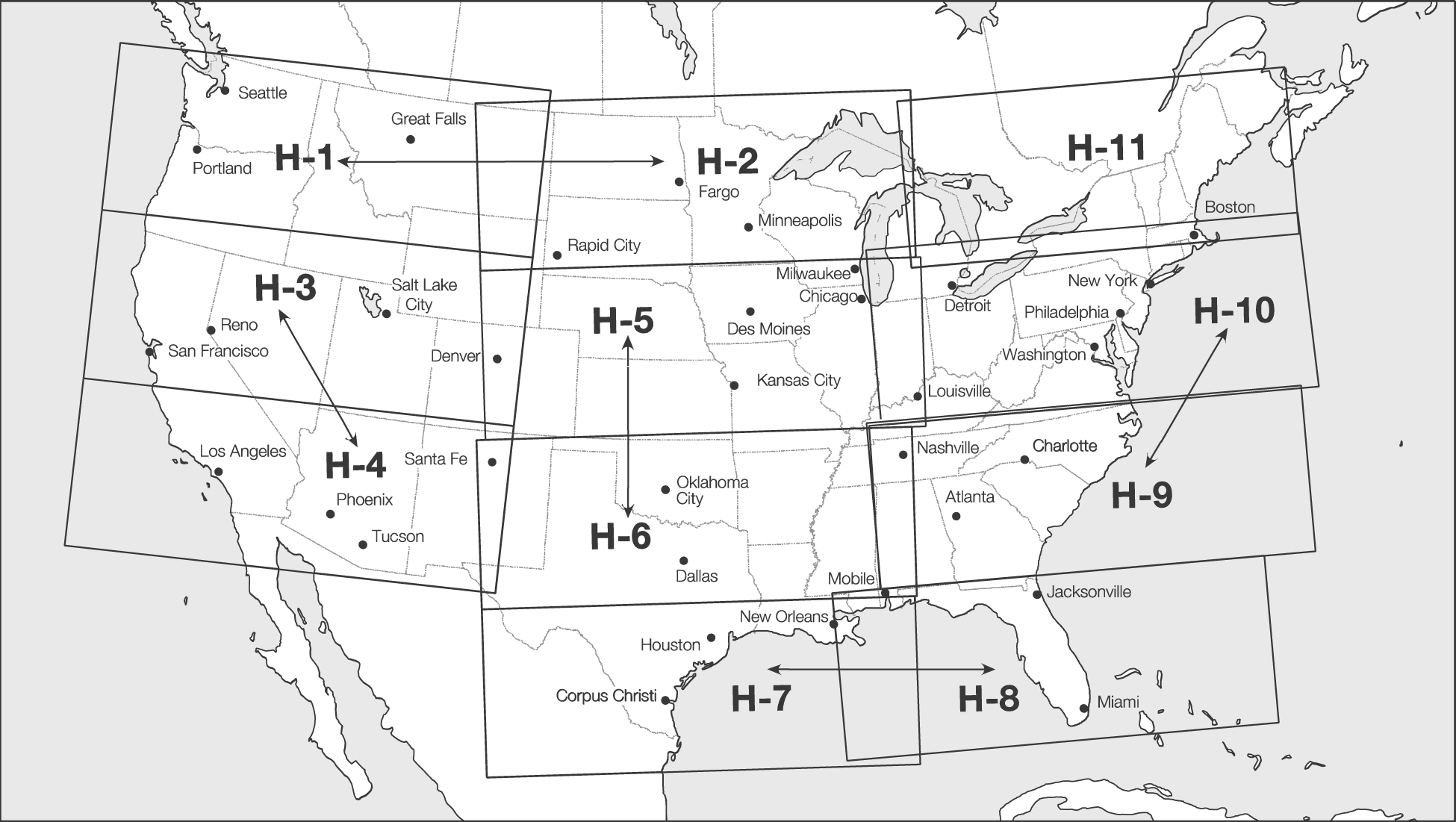
2. IFR Enroute High Altitude Charts
(Conterminous U.S. and Alaska). Enroute high
altitude charts are designed for navigation at or above
18,000 feet MSL. This four-color chart series
includes the jet route structure; VHF NAVAIDs with
frequency, identification, channel, geographic coordinates; selected airports; reporting points. Scales
vary from 1 inch = 45nm to 1 inch = 18nm. 55 x 20
inches folded to 5 x 10 inches. Revised every 56 days.
(See FIG 9-1-3 and
FIG 9-1-5.)
FIG 9-1-4
Alaska Enroute Low Altitude Chart
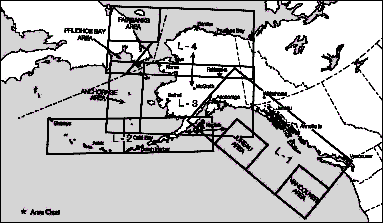
FIG 9-1-5
Alaskan Enroute High Altitude Chart
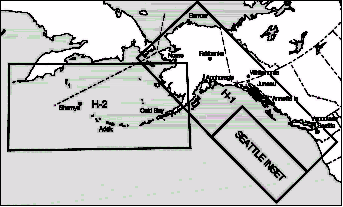
3. U.S. Terminal Procedures Publication
(TPP). TPPs are published in 24 loose-leaf or
perfect bound volumes covering the conterminous
U.S., Puerto Rico and the Virgin Islands. A Change
Notice is published at the midpoint between revisions
in bound volume format and is available on the
internet for free download at the NACO web site.
(See FIG 9-1-9.) The TPPs include:
(a) Instrument Approach Procedure (IAP)
Charts. IAP charts portray the aeronautical data that
is required to execute instrument approaches to
airports. Each chart depicts the IAP, all related
navigation data, communications information, and an
airport sketch. Each procedure is designated for use
with a specific electronic navigational aid, such as
ILS, VOR, NDB, RNAV, etc.
(b) Instrument Departure Procedure (DP)
Charts. DP charts are designed to expedite
clearance delivery and to facilitate transition between
takeoff and en route operations. They furnish pilots'
departure routing clearance information in graphic
and textual form.
(c) Standard Terminal Arrival (STAR)
Charts. STAR charts are designed to expedite ATC
arrival procedures and to facilitate transition between
en route and instrument approach operations. They
depict preplanned IFR ATC arrival procedures in
graphic and textual form. Each STAR procedure is
presented as a separate chart and may serve either a
single airport or more than one airport in a given
geographic area.
(d) Airport Diagrams. Full page airport
diagrams are designed to assist in the movement of
ground traffic at locations with complex runway/taxiway configurations and provide information for
updating geodetic position navigational systems
aboard aircraft. Airport diagrams are available for
free download at the NACO website.
4. Alaska Terminal Procedures Publication. This publication contains all terminal flight procedures for civil and military aviation in Alaska.
Included are IAP charts, DP charts, STAR charts,
airport diagrams, radar minimums, and supplementary support data such as IFR alternate minimums,
take-off minimums, rate of descent tables, rate of
climb tables and inoperative components tables.
Volume is 5-3/8 x 8-1/4 inch top bound. Publication
revised every 56 days with provisions for a Terminal
Change Notice, as required.
c. Planning Charts.
1. U.S. IFR/VFR Low Altitude Planning
Chart. This chart is designed for prefight and
en route flight planning for IFR/VFR flights.
Depiction includes low altitude airways and mileage,
NAVAIDs, airports, special use airspace, cities, times
zones, major drainage, a directory of airports with
their airspace classification, and a mileage table
showing great circle distances between major
airports. Scale 1 inch = 47nm/1:3,400,000. Chart
revised annually, and is available either folded or
unfolded for wall mounting. (See
FIG 9-1-6.)
2. Gulf of Mexico and Caribbean Planning
Chart. This is a VFR planning chart on the reverse
side of the Puerto Rico - Virgin Islands VFR Terminal
Area Chart. Information shown includes mileage
between airports of entry, a selection of special use
airspace and a directory of airports with their
available services. Scale 1 inch = 85nm/1:6,192,178.
60 x 20 inches folded to 5 x 10 inches. Chart revised
annually. (See
FIG 9-1-6.)

3. Charted VFR Flyway Planning Charts. This chart is printed on the reverse side of selected
TAC charts. The coverage is the same as the
associated TAC. Flyway planning charts depict flight
paths and altitudes recommended for use to bypass
high traffic areas. Ground references are provided as
a guide for visual orientation. Flyway planning charts
are designed for use in conjunction with TACs and
sectional charts and are not to be used for navigation.
Chart scale 1 inch = 3.43nm/1:250,000.
d. Supplementary Charts and Publications.
1. Airport/Facility Directory (A/FD). This
7-volume booklet series contains data on airports,
seaplane bases, heliports, NAVAIDs, communications data, weather data sources, airspace, special
notices, and operational procedures. Coverage
includes the conterminous U.S., Puerto Rico, and the
Virgin Islands. The A/FD shows data that cannot be
readily depicted in graphic form; e.g., airport hours of
operations, types of fuel available, runway widths,
lighting codes, etc. The A/FD also provides a means
for pilots to update visual charts between edition
dates (A/FD is published every 56 days while
sectional and Terminal Area Charts are generally
revised every six months). The VFR Chart Update
Bulletins are available for free download from the
NACO web site. Volumes are side-bound 5-3/8 x
8-1/4 inches. (See
FIG 9-1-10.)
2. Supplement Alaska. This is a civil/military
flight information publication issued by FAA every
56 days. It is a single volume booklet designed for use
with appropriate IFR or VFR charts. The Supplement
Alaska contains an A/FD, airport sketches, communications data, weather data sources, airspace, listing
of navigational facilities, and special notices and
procedures. Volume is side-bound 5-3/8 x
8-1/4 inches.
3. Chart Supplement Pacific. This supplement is designed for use with appropriate VFR or IFR
enroute charts. Included in this one-volume booklet
are the A/FD, communications data, weather data
sources, airspace, navigational facilities, special
notices, and Pacific area procedures. IAP charts, DP
charts, STAR charts, airport diagrams, radar
minimums, and supporting data for the Hawaiian and
Pacific Islands are included. The manual is published
every 56 days. Volume is side-bound 5-3/8 x
8-1/4 inches.
4. North Pacific Route Charts. These charts
are designed for FAA controllers to monitor
transoceanic flights. They show established intercontinental air routes, including reporting points with
geographic positions. Composite Chart: Scale
1 inch = 164nm/1:12,000,000. 48 x 41-1/2 inches.
Area Charts: Scale 1 inch = 95.9nm/1:7,000,000.
52 x 40-1/2 inches. All charts shipped unfolded.
Charts revised every 56 days. (See
FIG 9-1-8.)
5. North Atlantic Route Chart. Designed for
FAA controllers to monitor transatlantic flights, this
5-color chart shows oceanic control areas, coastal
navigation aids, oceanic reporting points, and
NAVAID geographic coordinates. Full Size Chart:
Scale 1 inch = 113.1nm/1:8,250,000. Chart is shipped
flat only. Half Size Chart: Scale 1 inch =
150.8nm/1:11,000,000. Chart is 29-3/4 x
20-1/2 inches, shipped folded to 5 x 10 inches only.
Chart revised every 56 weeks. (See
FIG 9-1-7.)
FIG 9-1-7
North Atlantic Route Charts
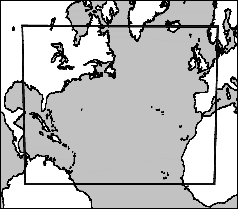
FIG 9-1-8
North Pacific Oceanic Route Charts
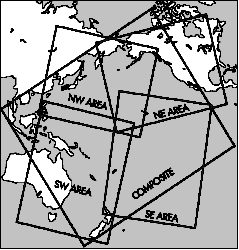
6. Airport Obstruction Charts (OC). The
OC is a 1:12,000 scale graphic depicting 14 CFR
Part 77, Objects Affecting Navigable Airspace,
surfaces, a representation of objects that penetrate
these surfaces, aircraft movement and apron areas,
navigational aids, prominent airport buildings, and a
selection of roads and other planimetric detail in the
airport vicinity. Also included are tabulations of
runway and other operational data.
7. FAA Aeronautical Chart User's Guide. A booklet designed to be used as a teaching aid and
reference document. It describes the substantial
amount of information provided on FAA's aeronautical charts and publications. It includes explanations
and illustrations of chart terms and symbols
organized by chart type. The users guide is available
for free download at the NACO web site.
e. Digital Products.
1. The Digital Aeronautical Information CD
(DAICD). The DAICD is a combination of the
NAVAID Digital Data File, the Digital Chart
Supplement, and the Digital Obstacle File on one
Compact Disk. These three digital products are no
longer sold separately. The files are updated every
56 days and are available by subscription only.
(a) The NAVAID Digital Data File. This
file contains a current listing of NAVAIDs that are
compatible with the National Airspace System. This
file contains all NAVAIDs including ILS and its
components, in the U.S., Puerto Rico, and the Virgin
Islands plus bordering facilities in Canada, Mexico,
and the Atlantic and Pacific areas.
(b) The Digital Obstacle File. This file
describes all obstacles of interest to aviation users in
the U.S., with limited coverage of the Pacific,
Caribbean, Canada, and Mexico. The obstacles are
assigned unique numerical identifiers, accuracy
codes, and listed in order of ascending latitude within
each state or area.
(c) The Digital Aeronautical Chart Supplement (DACS). The DACS is specifically designed
to provide digital airspace data not otherwise readily
available. The supplement includes a Change Notice
for IAPFIX.dat at the mid-point between revisions.
The Change Notice is available only by free
download from the NACO website.
The DACS individual data files are:
ENHIGH.DAT: High altitude airways (conterminous U.S.)
ENLOW.DAT: Low altitude airways (conterminous
U.S.)
IAPFIX.DAT: Selected instrument approach procedure NAVAID and fix data.
MTRFIX.DAT: Military training routes data.
ALHIGH.DAT: Alaska high altitude airways data.
ALLOW.DAT: Alaska low altitude airways data.
PR.DAT: Puerto Rico airways data.
HAWAII.DAT: Hawaii airways data.
BAHAMA.DAT: Bahamas routes data.
OCEANIC.DAT: Oceanic routes data.
STARS.DAT: Standard terminal arrivals data.
DP.DAT: Instrument departure procedures data.
LOPREF.DAT: Preferred low altitude IFR routes
data.
HIPREF.DAT: Preferred high altitude IFR routes
data.
ARF.DAT: Air route radar facilities data.
ASR.DAT: Airport surveillance radar facilities data.
2. The National Flight Database (NFD)
(ARINC 424 [Ver 13 & 15]). The NFD is a basic
digital dataset, modeled to an international standard,
which can be used as a basis to support GPS
navigation. Initial data elements included are: Airport
and Helicopter Records, VHF and NDB Navigation
aids, en route waypoints and airways. Additional data
elements will be added in subsequent releases to
include: departure procedures, standard terminal
arrivals, and GPS/RNAV instrument approach
procedures. The database is updated every 28 days.
The data is available by subscription only and is
distributed on CD-ROM or by ftp download.
3. Sectional Raster Aeronautical Charts
(SRAC). These digital VFR charts are geo-referenced scanned images of FAA sectional charts.
Additional digital data may easily be overlaid on the
raster image using commonly available Geographic
Information System software. Data such as weather,
temporary flight restrictions, obstacles, or other
geospatial data can be combined with SRAC data to
support a variety of needs. Most SRACs are provided
in two halves, a north side and a south side. The file
resolution is 200 dots per inch and the data is 8-bit
color. The data is provided as a GeoTIFF and
distributed on DVD-R media. The root mean square
error of the transformation will not exceed two pixels.
SRACs DVDs are updated every 28 days and are
available by subscription only.
FIG 9-1-9
U.S. Terminal Publication Volumes
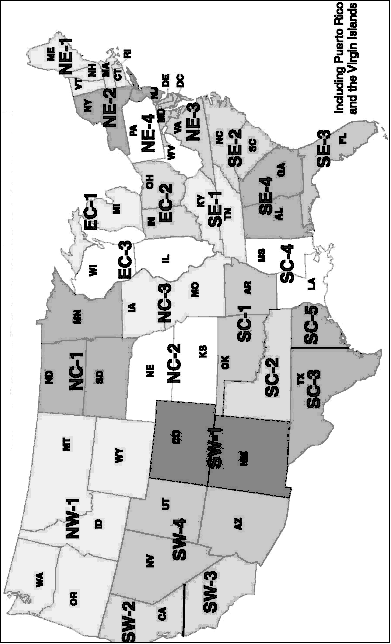
FIG 9-1-10
Airport/Facility Directory Geographic Areas
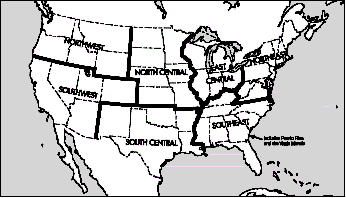
FIG 9-1-11
Sectional and VFR Terminal Area Charts for Alaska
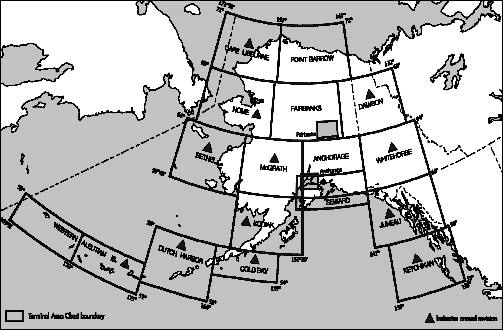
FIG 9-1-12
World Aeronautical Charts for Alaska

FIG 9-1-13
World Aeronautical Charts for the Conterminous U.S.
Mexico, and the Caribbean Areas
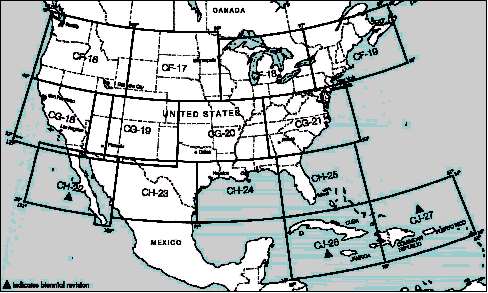
9-1-5. Where and How to Get Charts of
Foreign Areas
a. National Imagery and Mapping Agency
(NIMA) Products. An FAA catalog of NIMA Public
Sale Aeronautical Charts and Publications (FAA
Stock No. DMAACATSET), is available from the
NACO Distribution Division. The catalog describes
available charts and publications primarily covering
areas outside the U.S. A free quarterly bulletin, Dates
of Latest Editions - NIMA Aeronautical Charts and
Publications (FAA Stock No. DADOLE), is also
available from NACO.
1. Flight Information Publication (FLIP)
Planning Documents.
General Planning (GP)
Area Planning
Area Planning - Special Use Airspace -
Planning Charts
2. FLIP Enroute Charts and Chart Supplements.
Pacific, Australasia, and Antarctica
U.S. - IFR and VFR Supplements
Flight Information Handbook
Caribbean and South America - Low Altitude
Caribbean and South America - High Altitude
Europe, North Africa, and Middle East -
Low Altitude
Europe, North Africa, and Middle East -
High Altitude
Africa
Eastern Europe and Asia
Area Arrival Charts
3. FLIP Instrument Approach Procedures
(IAPs).
Africa
Canada and North Atlantic
Caribbean and South America
Eastern Europe and Asia
Europe, North Africa, and Middle East
Pacific, Australasia, and Antarctica
VFR Arrival/Departure Routes - Europe and Korea
U.S.
4. Miscellaneous DOD Charts and Products.
Aeronautical Chart Updating Manual (CHUM)
DOD Weather Plotting Charts (WPC)
Tactical Pilotage Charts (TPC)
Operational Navigation Charts (ONC)
Global Navigation and Planning Charts (GNC)
Global LORAN-C Navigation Charts (GLCC)
LORAN-C Coastal Navigation Charts (LCNC)
Jet Navigation Charts (JNC) and Universal Jet
Navigation Charts (JNU)
Jet Navigation Charts (JNCA)
Aerospace Planning Charts (ASC)
Oceanic Planning Charts (OPC)
Joint Operations Graphics - Air (JOG-A)
Standard Index Charts (SIC)
Universal Plotting Sheet (VP-OS)
Sight Reduction Tables for Air Navigation (PUB249)
Plotting Sheets (VP-30)
Dial-Up Electronic CHUM
b. Canadian Charts. Information on available
Canadian charts and publications may be obtained
from designated FAA chart agents or by contacting
the:
NAV CANADA
Aeronautical Publications
Sales and Distribution Unit
P.O. Box 9840, Station T
Ottawa, Ontario K1G 6S8 Canada
Telephone: 613-744-6393 or 1-866-731-7827
Fax: 613-744-7120 or 1-866-740-9992
c. Mexican Charts. Information on available
Mexican charts and publications may be obtained by
contacting:
Dirección de Navigacion Aereo
Blvd. Puerto Aereo 485
Zona Federal Del Aeropuerto Int'l
15620 Mexico D.F.
Mexico
d. International Civil Aviation Organization
(ICAO). A free ICAO Publications and Audio-
Visual Training Aids Catalogue is available from:
International Civil Aviation Organization
ATTN: Document Sales Unit
999 University Street
Montreal, Quebec
H3C 5H7, Canada
Telephone: (514) 954-8022
Fax: (514) 954-6769
E-mail: sales_unit@icao.org
Internet: http://www.icao.org/cgi/goto.pl?icao/en/sales.htm
Sitatex: YULCAYA
Telex: 05-24513
|












